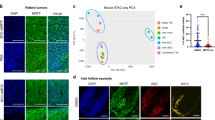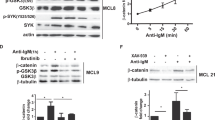Abstract
Basal cell carcinoma (BCC), the most common form of human cancer, is understood to be associated with activation of the sonic hedgehog pathway, through loss-of-function mutations of tumor suppressor PTCH1 or gain-of-function mutations of smoothened. Interferon (IFN)-based therapy is quite effective in BCC treatment, but the molecular basis is not well understood. Here we report a novel mechanism by which IFNα mediates apoptosis in BCCs. In the presence of IFNα, we observed increased apoptosis in a BCC cell line ASZ001, in which PTC is null, and therefore with constitutive activation of the sonic hedgehog pathway. We demonstrate that SMO agonist Ag-1.4 mediates activation of extracellular signal-regulated kinase (Erk) phosphorylation, which is abrogated by IFNα in sonic hedgehog responsive C3H10T1/2 cells. In transient transfection experiments, we demonstrate that IFNα inhibits Erk phosphorylation and serum response element activation induced by expression of SMO, Gli1, PDGFRα and activated Raf, but not activated mitogen-activated Erk-regulating kinase (Mek), suggesting that IFNα targets mainly on Mek function. We further show that IFNα induces expression of Fas in BCC cells through interfering with Mek function. The role of the Fas-L/Fas signaling axis in IFNα-mediated apoptosis is demonstrated by the fact that addition of Fas-L neutralizing antibodies, just as caspase-8 inhibitor Z-IETD-FMK, effectively prevents IFNα-mediated apoptosis. Thus, our data indicate that IFNα-based BCC therapy induces Fas expression and apoptosis through interfering with Mek function.
This is a preview of subscription content, access via your institution
Access options
Subscribe to this journal
Receive 50 print issues and online access
$259.00 per year
only $5.18 per issue
Buy this article
- Purchase on Springer Link
- Instant access to full article PDF
Prices may be subject to local taxes which are calculated during checkout






Similar content being viewed by others
References
Aszterbaum M, Rothman A, Johnson RL, Fisher M, Xie J, Bonifas JM, Zhang X, Scott MP and Epstein Jr EH . (1998). J. Invest. Dermatol., 110, 885–888.
Bodak N, Queille S, Avril MF, Bouadjar B, Drougard C, Sarasin A and Daya-Grosjean L . (1999). Proc. Natl. Acad. Sci. USA, 96, 5117–5122.
Buechner SA, Wernli M, Harr T, Hahn S, Itin P and Erb P . (1997). J. Clin. Invest., 100, 2691–2696.
Chimenti S, Peris K, Di Cristofaro S, Fargnoli MC and Torlone G . (1995). Dermatology, 190, 214–217.
Darnell Jr JE . (1996). Recent Prog. Horm. Res., 51, 391–403.
Epstein Jr E . (2001). Med. Pediatr. Oncol., 36, 555–558.
Fenton RG, Hixon JA, Wright PW, Brooks AD and Sayers TJ . (1998). Cancer Res., 58, 3391–3400.
Filipowicz E, Adegboyega P, Sanchez RL and Gatalica Z . (2002). Cancer, 94, 814–819.
Frank-Kamenetsky M, Zhang XM, Bottega S, Guicherit O, Wichterle H, Dudek H, Bumcrot D, Wang FY, Jones S, Shulok J, Rubin LL and Porter JA . (2002). J. Biol., 1, 10.1–10.19.
Gailani MR, Stahle-Backdahl M, Leffell DJ, Glynn M, Zaphiropoulos PG, Pressman C, Unden AB, Dean M, Brash DE, Bale AE and Toftgard R . (1996). Nat. Genet., 14, 78–81.
Goodrich LV, Milenkovic L, Higgins KM and Scott MP . (1997). Science, 277, 1109–1113.
Gorlin RJ . (1987). Medicine (Baltimore), 66, 98–113.
Grob JJ, Collet AM, Munoz MH and Bonerandi JJ . (1988). Lancet, 1, 878–879.
Gutierrez-Steil C, Wrone-Smith T, Sun X, Krueger JG, Coven T and Nickoloff BJ . (1998). J. Clin. Invest., 101, 33–39.
Hahn H, Wojnowski L, Zimmer AM, Hall J, Miller G and Zimmer A . (1998). Nat. Med., 4, 619–622.
Hottiger MO, Dam TN, Nickoloff BJ, Johnson TM and Nabel GJ . (1999). Gene Ther., 6, 1929–1935.
Kazama H and Yonehara S . (2000). J. Cell. Biol., 148, 557–566.
Lam CW, Xie J, To KF, Ng HK, Lee KC, Yuen NW, Lim PL, Chan LY, Tong SF and McCormick F . (1999). Oncogene, 18, 833–836.
Larner A and Reich NC . (1996). Biotherapy, 8, 175–181.
Lee SH, Jang JJ, Lee JY, Kim SY, Park WS, Shin MS, Dong SM, Na EY, Kim KM, Kim CS, Kim SH and Yoo NJ . (1998). Br. J. Dermatol., 139, 186–191.
McCormick F . (1994). Curr. Opin. Genet. Dev., 4, 71–76.
Miller DL and Weinstock MA . (1994). J. Am. Acad. Dermatol., 30 (5 Part 1), 774–778.
Peli J, Schroter M, Rudaz C, Hahne M, Meyer C, Reichmann E and Tschopp J . (1999). EMBO J., 18, 1824–1831.
Reifenberger J, Wolter M, Weber RG, Megahed M, Ruzicka T, Lichter P and Reifenberger G . (1998). Cancer Res., 58, 1798–1803.
Romerio F and Zella D . (2002). FASEB J., 16, 1680–1682.
Toftgard R . (2000). Cell Mol. Life Sci., 57, 1720–1731.
Vander Straten M, Lee P, Weitzul S, Cockerell CJ and Tyring SK . (2000). Adv. Dermatol., 16, 299–318.
Vorechovsky I, Tingby O, Hartman M, Stromberg B, Nister M, Collins VP and Toftgard R . (1997a). Oncogene, 15, 361–366.
Vorechovsky I, Unden AB, Sandstedt B, Toftgard R and Stahle-Backdahl M . (1997b). Cancer Res., 57, 4677–4681.
Wolter M, Reifenberger J, Sommer C, Ruzicka T and Reifenberger G . (1997). Cancer Res., 57, 2581–2585.
Xie J, Aszterbaum M, Zhang X, Bonifas JM, Zachary C, Epstein E and McCormick F . (2001). Proc. Natl. Acad. Sci. USA, 98, 9255–9259.
Xie J, Johnson RL, Zhang X, Bare JW, Waldman FM, Cogen PH, Menon AG, Warren RS, Chen LC, Scott MP and Epstein Jr EH . (1997a). Cancer Res., 57, 2369–2372.
Xie J, Murone M, Luoh SM, Ryan A, Gu Q, Zhang C, Bonifas JM, Lam CW, Hynes M, Goddard A, Rosenthal A, Epstein Jr EH and de Sauvage FJ . (1998). Nature, 391, 90–92.
Xie J, Quinn A, Zhang X, Bare J, Rothman A, Collins C, Cutone S, Rutter M, McCormick MK and Epstein Jr E . (1997b). Genes Chromosomes Cancer, 18, 305–309.
Acknowledgements
We thank Drs Ervin Epstein and Michelle Aszterbaum for providing reagents and members of the Sealy Center for Cancer Cell Biology for discussion. This study was supported by an R01 grant from NCI (JX), the NIEHS center (JX) and John Sealy Memorial Endowment Fund for Biomedical Research (JX).
Author information
Authors and Affiliations
Corresponding author
Rights and permissions
About this article
Cite this article
Li, C., Chi, S., He, N. et al. IFNα induces Fas expression and apoptosis in hedgehog pathway activated BCC cells through inhibiting Ras-Erk signaling. Oncogene 23, 1608–1617 (2004). https://doi.org/10.1038/sj.onc.1207273
Received:
Revised:
Accepted:
Published:
Issue Date:
DOI: https://doi.org/10.1038/sj.onc.1207273
Keywords
This article is cited by
-
Cutaneous carcinosarcoma: further insights into its mutational landscape through massive parallel genome sequencing
Virchows Archiv (2014)
-
Activation of the hedgehog pathway in chronic myelogeneous leukemia patients
Journal of Experimental & Clinical Cancer Research (2011)
-
Basal cell carcinomas: attack of the hedgehog
Nature Reviews Cancer (2008)
-
Adenovirus delivery provides extended interferon-α exposure and augments treatment of metastatic carcinoma
Cancer Gene Therapy (2006)
-
Interferons α and γ induce p53-dependent and p53-independent apoptosis, respectively
Oncogene (2005)



